ALP 12.9%
Incumbent MP
Tanya Plibersek, since 1998.
Geography
Inner suburbs of Sydney. Sydney covers most of the City of Sydney and a small part of the Marrickville council area. The seat covers the Sydney CBD, Pyrmont, Ultimo, Surry Hills, Redfern, Waterloo, Alexandria, Potts Point, Woolloomooloo, Darlinghurst, Erskineville, Glebe, parts of Newtown, and the southern parts of the City of Sydney, extending as far south as Rosebery.
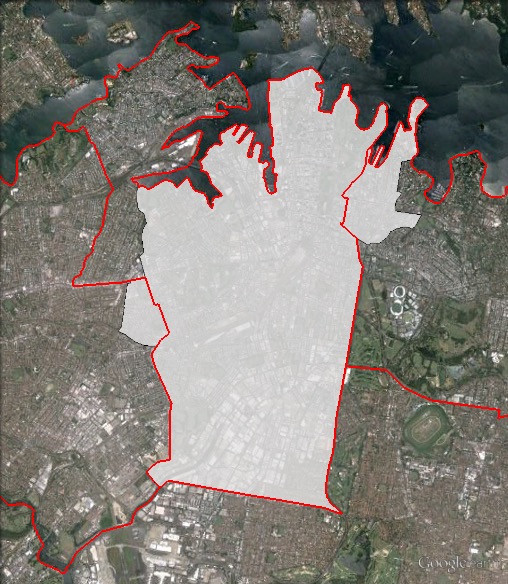
Redistribution
Sydney gained Potts Point, Woolloomooloo and parts of Darlinghurst from Wentworth, lost Balmain, Rozelle and Annandale to Grayndler and gained parts of Newtown from Grayndler.
History
Sydney was created for the 1969 election by the merger of the seats of East Sydney and West Sydney, which had existed since federation.
Sydney has been held by the ALP ever since its creation, and its predecessors had almost always been held by Labor.
West Sydney (which, despite its name, actually covered inner city suburbs like Darling Harbour and Pyrmont) always elected a Labor MP, although it was briefly held by a conservative party from 1916 to 1917, as its first MP was Billy Hughes, who as Prime Minister left the ALP and formed the Nationalist party. He proceeded to move to a different seat at the 1917 election, and the ALP held West Sydney from 1917 until its abolition, although Jack Beasley, who held the seat for eighteen years, left the ALP to join a Lang Labor breakaway party on two occasions in the 1930s and 1940s.
The seat of East Sydney was first held by George Reid, a former NSW premier and leader of the Free Trade party, from 1901 to 1909, when he retired. John West (ALP) won the seat in 1910 and held it until his death in February 1931. The ensuing by-election was won by Eddie Ward, who left the ALP later that year when he was one of a number of supporters of NSW Labor leader Jack Lang to cross the floor and bring down the Scullin government.
East Sydney was won at the 1931 election by John Clasby (UAP) who benefited from a split Labor vote, with the two Labor parties gaining 55% of the primary vote but enough preferences from the official ALP leaking to Clasby to see Ward lose. Clasby died a month later without taking his seat and Ward won back the seat at a January 1932 by-election, less than a year after he had previously won the seat at a by-election. Ward returned to the ALP in 1936 and the ALP held the seat from then until its abolition in 1969.
The new seat of Sydney was first won in 1969 by Jim Cope. Cope had previously held the seats of Cook and Watson before their abolitions. Neither seats have any connection to the modern seats with those names. Both Cook and Watson had covered parts of South Sydney now covered by Sydney. Cope had won Cook at a 1955 by-election following the death of the previous member, but the seat was abolished at the general election in the same year. Cope then held Watson from 1955 until it too was abolished in 1969, at which point he moved to the new seat of Sydney.
Cope held Sydney until 1975, and served as Speaker of the House of Representatives from 1973 until a dispute with the Whitlam government saw him resign in protest in 1975.
Cope was succeeded in 1975 by Leslie McMahon (ALP), who served until he was defeated for preselection before the 1983 election.
The seat was won in 1983 by Peter Baldwin, previously a Member of the Legislative Council who had become a symbol of the conflict between the Left and Right within the ALP in the Inner West in 1980 when he was brutally bashed in his home. Baldwin served as a federal minister from 1990 to 1996 and retired at the 1998 election.
The seat has been held since 1998 by Tanya Plibersek. Plibersek served as a minister during the last Labor government, and has served as deputy Labor leader since 2013.
Candidates
- Ula Falanga (Christian Democratic Party)
- Mark Berriman (Animal Justice)
- Kris Spike (Sustainable Australia)
- Geoffrey Winters (Liberal)
- Tom Geiser (Science Party)
- Sylvie Ellsmore (Greens)
- Peter Boyle (Socialist Alliance)
- Tanya Plibersek (Labor)
- Rebecca Lanning (Sex Party)
- Tula Tzoras (Online Direct Democracy)
Assessment
Sydney is one of the strongest seats for the Greens in Sydney. If the Greens managed to overtake the Liberal Party, and they benefited from Liberal preferences, they could seriously challenge for the seat.
The current voting figures suggest a very large gap between Liberal and Greens, but this gap was much smaller before a large swing against the Greens in 2013. The Greens have not run as effective campaigns in the area in federal elections as they have been able to run in the state seats of Balmain and Newtown.
The booths in the same area were very friendly to the Greens at the 2015 state election. State election results are not directly comparable, but they indicate a level of potential Greens support which could be tapped by an effective marginal seat campaign.
2013 result
| Candidate | Party | Votes | % | Swing | Redist |
| Tanya Plibersek | Labor | 40,579 | 46.0 | +2.7 | 43.8 |
| Sean O’Connor | Liberal | 26,901 | 30.5 | +2.4 | 31.9 |
| Dianne Hiles | Greens | 15,273 | 17.3 | -6.4 | 18.5 |
| Jane Ward | Independent | 1,408 | 1.6 | +0.1 | 1.4 |
| Timothy Daniel Kelly | Palmer United Party | 1,261 | 1.4 | +1.4 | 1.4 |
| Leah Gartner | Bullet Train For Australia | 791 | 0.9 | +0.9 | 0.9 |
| Lesley Mason | Christian Democratic Party | 723 | 0.8 | +0.8 | 0.9 |
| Peter Boyle | Socialist Alliance | 613 | 0.7 | +0.7 | 0.6 |
| Joanna Rzetelski | Independent | 602 | 0.7 | +0.7 | 0.6 |
| Others | 0.2 | ||||
| Informal | 5,830 | 6.6 |
2013 two-party-preferred result
| Candidate | Party | Votes | % | Swing | Redist |
| Tanya Plibersek | Labor | 56,994 | 64.7 | -2.4 | 62.9 |
| Sean O’Connor | Liberal | 31,157 | 35.4 | +2.4 | 37.1 |
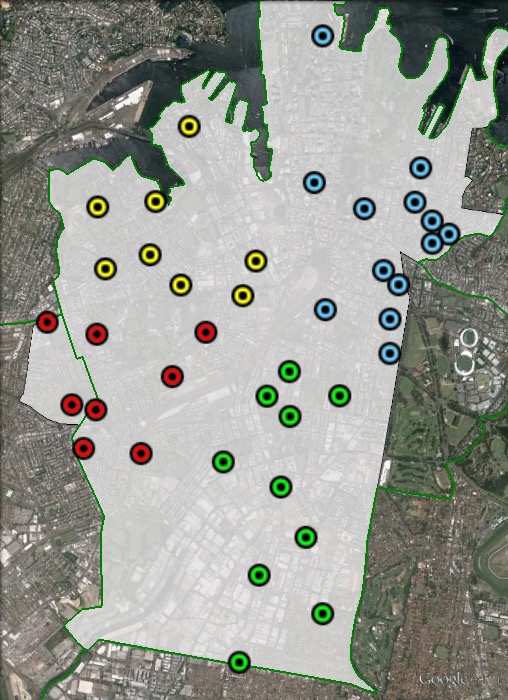
Booth breakdown
Booths have been divided into four parts:
- North-East – Darlinghurst, Kings Cross, Millers Point, Sydney CBD, Surry Hills, Woolloomooloo
- North-West – Glebe, Pyrmont, Ultimo
- South-East – Alexandria, Redfern, Rosebery, Waterloo, Zetland
- South-West – Camperdown, Darlington, Erskineville, Newtown
Labor topped the primary vote in all three areas, with around 47-49% in three areas and 39% in the north-east.
The Liberal Party was highest at 37% in the north-east, and lowest at 16% in the south-west.
The Greens vote ranged from 14% in the south-east to 29% in the south-west. The Greens outpolled the Liberal Party in the south-west.
| Voter group | ALP % | LIB % | GRN % | Total votes | % of votes |
| North-East | 39.0 | 37.2 | 18.4 | 16,493 | 20.6 |
| South-East | 48.4 | 31.3 | 14.2 | 12,358 | 15.5 |
| North-West | 47.0 | 29.0 | 18.0 | 11,897 | 14.9 |
| South-West | 49.7 | 16.3 | 29.0 | 11,393 | 14.3 |
| Other votes | 40.7 | 36.6 | 16.3 | 27,740 | 34.7 |
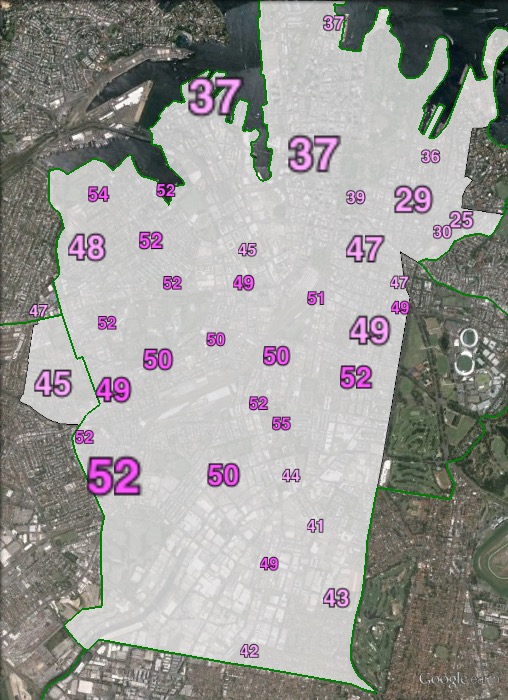
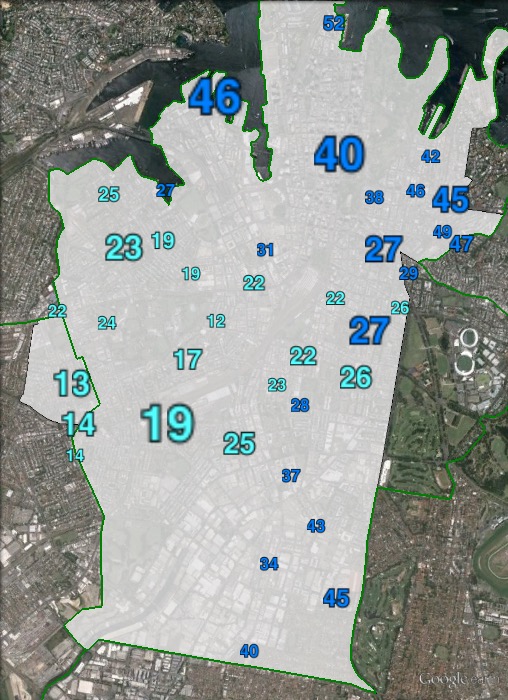
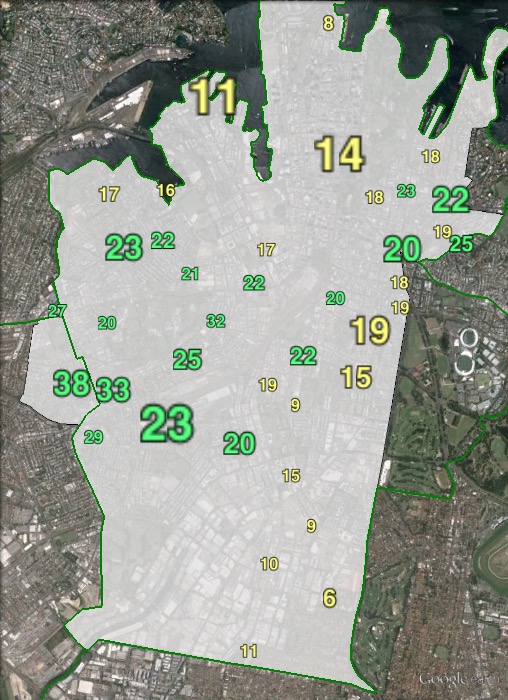


I don’t think Plibersek will lose. If the Greens can tap into the vote they received during the state election then it could be a contest between the Libs and the Greens as to finishes second.
In 2015 in this seat, the Greens polled 30%, Labor polled 29% and Liberal polled 24%. I don’t think that will happen in 2016, but if it did the Libs and Greens wouldn’t be competing for second place.
I would imagine Plibersek’s personal vote dampens the potential the Greens here, same with Albo in Grayndler.
I take it that your comment about Greenwich on the Batman post was actually supposed to be here?
Oops, here it is:
Oh and 13% voted for Greenwich – take your guess about where those votes would’ve gone.
Clearly state Labor have been in a worse state than federal Labor, and Plibersek will have a personal vote, but this will be a stronger Greens campaign and their vote will clearly go up a fair bit.
The Liberal vote is probably too high here for the Greens to be a serious chance. Unlike Melbourne or Batman, the Libs do have a solid base in the seat with all the inner city developments.
The Liberal vote is definitely a higher bar in Sydney than in other Labor-Greens seats, but they got within 4% in 2010 before the disastrous 2013 election – it’s still very doable.
The Greens have no chance here, while Tanya rules supreme. If the Greens had half a brain they would have preferenced the libs years ago, to get rid of her. Strategic thinking, let alone political tactics are clearly beyond them.
If the Greens had preferenced the Liberals in Sydney, their vote would have cratered, and none of their voters (who are notoriously independent) would have followed that advice.
Ben
Not necessarily. They would have had to communicate their motives, & actually persuade voters. Not their forte i’ll agree. The reality remains that TP is dug in here, & they have few options if they want to dig her out. I hope they do.
But ordinary voters aren’t going to think that way. Most people voting Green will prefer Tanya to a Liberal and will vote accordingly.
I agree that Plibersek is a strong candidate – in all likelihood the best chance for the Greens will come when she retires. But it’s nonsense to think that helping elect a Liberal would be anything other than a disaster for the Greens in this strongly left-wing electorate.
Nick C & Ben
Making , & advocating a case, is supposed to be the BUSINESS of pollies. Just because it is challenging, doesn’t mean it can’t be done, or ought not to be attempted. If pollies can’t see a message, they ought to, & need to learn of salespeople. Their ineptness far from abrogates them, from their responsibility of effective communication, & representation.
As a former rep, i’d be confident selling most , if not all messages , pollies baulk at. By my standards, & experience, they are mostly gutless, hopeless, wimps, who would starve in the real world !!!.
Well firstly election campaigns aren’t quite the same as selling a product. Secondly, they are about who will govern the country/represent your area for the next 3 years, not the 3 years following that. It’s just not a plausible or realistic strategy for a party to persuade voters to help elect the party they least like for 3 years in the belief that they could then elect them more easily in 3 years time.
It’s true when I was a member of the Greens that sometimes you’d have a member pose the question ‘hey, what if we preferenced the Liberals so we could wipe out the ALP and then replace them?’, but I don’t think anyone really thinks of it as anything more than a fun conversation topic. It’s not something anyone would do in practice. Destroying any credibility that you stood for any principles is far more damaging to a third party in our system than any possible way they could gain from it – people would just revert to voting for whichever of the old parties they have any leaning towards. So in this scenario at least 50% of Greens voters would just switch their votes to Plibersek anyway.
It’s a perhaps entertaining hypothetical scenario but not a real-world strategy.
Nick C
I do find it quite fascinating to hear the scenario, has actually been discussed,beyond idle consideration. I thank you for such a thoughtful response, particularly as it is based on your own first hand experience.
Interestingly Michael Kroger is pushing the VIC libs to virtually persue this strategy, if not one close to it. We shall see if, & how this might work.
WRT to principles, well they always come at a price !!!. The greens appear to be grappling with this reality quite deeply ATM.
I deeply admired the position David Shoebridge took on (not ) preferencing the ALP in the 2011 state election. Perhaps if the Greens were to take a stand on union corruption, as a platform for example ??
winediamond: sure, the Greens COULD preference the Liberals ahead of Labor here, but they aren’t going to do that because it goes against their principles to preference their polar opposites in a cynical attempt at scoring political points, it goes against the wishes of a left leaning electorate, and it goes against the wishes of their own voters.
Fact is, Greens voters would rather Tanya Plibersek as an MP rather than a Liberal MP. Fact is, a left leaning electorate would rather Tanya Plibersek as their MP rather than a Librrak MP. Fact is, the Greens aren’t going to preference their polar opposites and risk handing government to the Liberal Party when the policies of the Labor Party are more favourable with their support base.
“handing the government to the Liberal Party” is far from a theoretical risk, too – imagine if they’d tried this and pulled it off in 2010!
The Liberals in Victoria are in a different position – as far as the make-up of Parliament goes it doesn’t really matter to them whether there’s a Green or an ALP member in a given seat, and they know that by forcing their main opponent to divert resources to an otherwise-safe seat, it reduces the resources they have to deploy against the Liberals elsewhere.
No, I never encountered it being discuseed ‘beyond idle conversation’. Idle conversation is the only context in which I ever encountered anyone in the Greens raising such an idea, and that was my point, some activist somewhere from time to time might say ‘Labor are such a disappointment, why couldn’t we do this?’, but it’s not a real discussion that takes place within the party at any official or unofficial level. It’s not raised by any serious people.
As much as I have enjoyed discussions on this seat over the years, the electoral boundaries have changed, and so must I – off to discover the Grayndler thread, my new electoral home…
Maybe “because it clashes with everything the party stands for” is a reason?
In one way this is actually easier for The Greens to win than Grayndler, because the ALP primary vote is just that bit lower.
The Greens will never win Sydney while Plibersek is there, it would take something short of a miracle to dislodge her.
Antony Green has a good blog post up, exploring the 8 seats the Greens have said they are targeting.
It explains pretty clearly the differences between Sydney and other inner-city seats such as Grayndler, Wills, and Batman.
The Greens polled 23.5% of the senate votes in Sydney at the last election, so clearly Plibersek has strong local support. It’s a seat that is probably going to move further towards the Greens but it’s hard to see her losing while she is still the MP.
Cope`s resignation was in line with Westminster System tradition. He named an MP and the vote to suspend the MP was defeated because the government opposed it (because it was, unusually, an opposition motion and the MP named was a government minister) and Westminster System tradition (based on a more non-partisan speaker than in Australia, leading to it not always being observed in Australia) demands resignation in such an event.
Thanks for the Antony Green tip MM, his observations seem spot on. He says Greens voters are more likely to come from the areas where there is terrace and free-standing housing stock available – the type preferred by preferred by gentrifiers. Which explains Grayndler, Batman, Wills, Melbourne Ports etc, all the Labor seats considered “in play” this time.
In Sydney (electorate) any housing stock like that costs at least $1.5m, more like $2 to $3m, and there’s virtually none left anyway. Which suggests the Greens have peaked here – with or without Plibersek standing. Those buying or renting apartments around Broadway, Ultimo, Waterloo and Green Square are younger, more aspirational, have less money to spend and (a lot of people don’t like to even say this), often Asian. Hardly fertile territory for the Greens – and they know that… Could explain why they routinely oppose the building of high-rise apartments – ironically, the only affordable housing type now possible in this electorate.
On the redistributed numbers pretty much just a slight swing to Labor from Liberals.
Interesting to note that in Kings Cross and Darlinghurst, transferred from Wentworth in the redistribution, there were mammoth 15% swings to Labor.
A clear reflection of replacing a popular high profile Liberal MP with an equally popular and high profile Labor one.